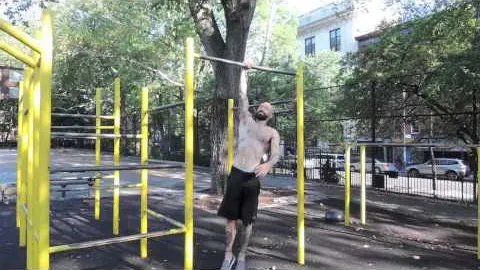
Welcome to our website, where we will guide you through the benefits and techniques of the Dead Hang One Arm Pull-up exercise. This challenging exercise targets your upper body strength, specifically your back, shoulders, and arms. Whether you are a seasoned fitness enthusiast or just starting your fitness journey, incorporating the Dead Hang One Arm Pull-up into your routine can take your strength training to the next level.
The Dead Hang One Arm Pull-up offers a wide array of benefits for your overall fitness and strength gains. Here are some of the key advantages of including this exercise in your routine:
The Dead Hang One Arm Pull-up is an advanced pulling movement that primarily targets the latissimus dorsi (back muscles), biceps, and forearms. By performing this exercise, you will experience significant gains in upper body strength and muscular development.
As you progress in your Dead Hang One Arm Pull-up journey, you will notice a significant improvement in your grip strength. The single-arm nature of this exercise requires a strong grip to support your body weight, leading to enhanced grip strength that can benefit other exercises and daily activities.
Performing the Dead Hang One Arm Pull-up challenges your stability, requiring your core muscles to engage throughout the movement. These muscles include the rectus abdominis, obliques, and deep stabilizers. Strengthening your core will not only aid in executing this exercise efficiently, but it will also improve your overall posture and body control.
The Dead Hang One Arm Pull-up is an exceptionally difficult exercise that often requires months or even years of practice to master. It offers a unique opportunity for personal challenge and growth by setting goals and working towards achieving them. As you progress, you can modify the exercise by adding weight or using different grips to continually challenge your muscles.
Before attempting the Dead Hang One Arm Pull-up, it is important to have a solid foundation in regular pull-ups and have developed considerable upper body strength. Here is a step-by-step guide on how to perform the exercise correctly:
Warm-up: Begin with a general upper body warm-up, including light cardio and dynamic stretches to prepare your muscles for the workout.
Grip Strength Development: Since grip strength is crucial for this exercise, incorporate grip-specific exercises such as farmer's walks and plate pinches into your routine to strengthen your grip.
Begin with Assisted One Arm Pull-ups: Start by using an assisted pull-up machine or resistance bands to gradually decrease the assistance as you build strength and confidence.
One Arm Negatives: Perform one arm negatives by using your non-working arm to assist the concentric (pulling up) portion of the movement, while controlling the eccentric (lowering down) portion with your working arm.
Progress to Dead Hang One Arm Pull-up: Once you have built sufficient strength and control, attempt the Dead Hang One Arm Pull-up by grasping the pull-up bar with a shoulder-width underhand grip, fully extending your non-working arm, and slowly pulling yourself up using your working arm. Aim to bring your chin above the bar and gradually lower yourself back down to a dead hang position.
Maintain Proper Form: Throughout the exercise, focus on maintaining proper form by keeping your torso stable, engaging your core, and avoiding excessive swinging or kipping movements.
To ensure safety and maximize the effectiveness of the Dead Hang One Arm Pull-up exercise, keep the following precautions and tips in mind:
Gradual Progression: As this exercise can place significant stress on your joints and connective tissues, it is crucial to progress gradually and listen to your body to prevent injuries.
Proper Recovery: Allow sufficient time for your muscles to recover between workouts, as intense training without adequate rest can lead to overuse injuries.
Use Proper Equipment: Make sure the pull-up bar or equipment you use is sturdy and can support your body weight with ease. Test it before attempting the exercise to ensure your safety.
Seek Professional Guidance: If you are new to strength training or have any pre-existing conditions or injuries, it is advisable to consult a fitness professional for proper guidance and modification of exercises.
Incorporating the Dead Hang One Arm Pull-up into your fitness routine can elevate your upper body strength, improve your grip strength, and challenge you both mentally and physically. Remember to approach this exercise with patience, dedication, and proper form, gradually progressing to achieve a full one-arm pull-up. By adhering to safety precautions and seeking professional guidance, you can safely integrate this exercise into your training and reap its numerous benefits. So, grab that pull-up bar and start working towards mastering the Dead Hang One Arm Pull-up today!
If you're looking for a gym, fitness club or yoga studio, you've come to the right place.
You can find information about gyms in your area. Browse catalog of gyms and find gyms with classes which are you looking for.
On gym page you can find simple information like address, phone or website. You can find list of available classes. You can check availability of personal training or small group classes. On place page you can also see information about open hours.
You can find gyms near you with amenities, courts, studios and equipments.
Use our map to find gym at your city or district.
In Gym Navigator you can find list of exercises with movies for many body parts.
You can browse exercises catalog and find exercises the best of you.
You can also find exercises grouped into workout plans, which you can use to improve you body. Each routine show you exercises one by one and give you possibility to count you progress and count down rest time.